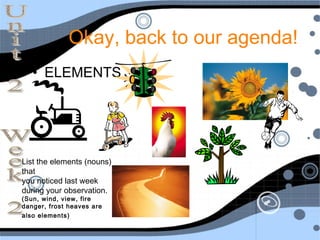
*Unit2 week2lecture11
- 1. Okay, back to our agenda! • ELEMENTS List the elements (nouns) that you noticed last week during your observation. (Sun, wind, view, fire danger, frost heaves are also elements)
- 2. How permanent is each element? • Did each element seem happy? • In your observations, did you notice anything that seemed unhappy? Too crowded? Too alone? Too…… • What could you move? Change? • How could you make each • element happy ?
- 3. There once was a man named PA Yeomans • Permaculture owes a lot to this man. Through trial and error and lots of observation, Persival Alfred (PA) developed what he called a “Scale of Permanence”
- 4. Scale of Permanence Thanks, Owen, for the graphic
- 5. Those are the basic elements • Did you note all of those things last week when you observed? • Don’t worry. I’m going to give you a chance to do it again.
- 6. I’m getting tired…. Are you? Why don’t you take a break, dream about a nice place to be. Grab a snack or a cup of tea While you are dreaming.
- 7. Our LAST agenda item: • Sectors and Zones Do a little dance, sing a little song! Get done tonight! Get done tonight!
- 8. SECTORS are exactly that
- 9. If you look back at Yeomans Scale of Permanence • You simply map those elements starting at the top. • Climate: sun/wind/snow/fire • Landshape: slope • Water: • Roads for animals and people • Trees (if there are a lot) • Structures and views • (you don’t have to map soils)
- 10. Zones • Are all about YOU. Since you are an element in a system, you need to place any new elements closest to you. • Permaculture is all about saving energy and with ZONES, we’re talking about YOUR energy.
- 11. The things that take the most attention/energy from you should be the closest to you. Source
- 12. Usually you see ZONES shown like this. However, it’s Never this neat! Source
- 13. And now….. for a quick lecture! Insert lecture on relationships
- 14. So, now are you ready? It’s time for your assignment! OOPS. First things first! Of course, you should do your Blog Post first. Go back over your notes and synthesize them, make them YOURS, integrate the information you’ve gleaned, Then POST to your blog! I’ll be looking forward to reading them! (They usually tell me what I forgot to tell you! :-)
- 15. See you later! I’ll catch you over at Unit2 Week 2 Assignment Whenever you are ready. Don’t you just love a-synchronous classes? I do!